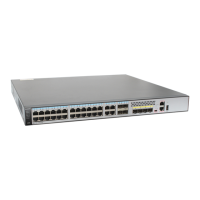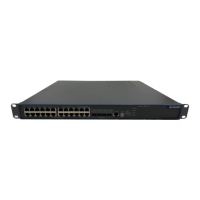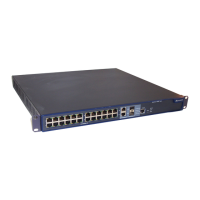NAT
In HGMP, member switches in a cluster can communicate with devices in the public network
through Network Address Transmission (NAT). Whether to use NAT for the communication
can be controlled through commands.
l The administrator switch is the management device in a cluster. To ensure the
communication between devices in and out of the cluster, you need to assign a public IP
address to the administrator switch.
l To ensure that devices in and out of the cluster can communicate through NAT, you need
to enable NAT of specified protocols on the administrator switch.
l NAT rules used by a cluster are automatically configured by the administrator switch. When
member switches access devices out of the cluster, they can automatically obtain the
interface mapped through NAT; when devices out of the cluster access member switches,
they need to calculate the number of the port of specified services on member switches.
Batch Distribution
HGMP can perform batch distribution over all the member switches under its management.
Objects to be distributed in batches include: the system software, configuration files, patch files.
l The batch distribution command can be performed only on the administrator switch.
l The administrator switch can be configured with the plug-and-play IP address, user name,
and password. If no IP address, user name, or password are specified in the command, the
plug-and-play IP address, user name, and password are adopted. If neither kinds of IP
address, user name, and password are configured, the command cannot be performed.
l Member switches download specified files from the FTP server and then set them as the
default files for the next startup.
l To avoid congestion, you can set the maximum number of member switches that
concurrently download files from the FTP server.
Batch Restart
HGMP can perform batch restart over a specified group of member switches.
l During the process of batch restart, member switches do not save the current configuration.
l After receiving the batch restart command, member switches wait 1 second to guarantee
the pervasion of control packets throughout the cluster.
Incremental Configuration
In a cluster, some member switches may have the same configurations, such as creating a VLAN
and enabling a feature. The incremental configuration function is used to remotely control the
selected member switches in batches. With this mode, you only need to configure a control
command list on the administrator switch. Then, you can deliver the control command list to
member switches at a time and query the control command output on each member switch. The
member selection mode can be all, device type-based, member switch ID-based, or IP address-
based.
l Incremental configuration can be performed only on the administrator switch.
l Incremental configuration is applied to the scenario of configuring member switches in
batches and is performed once on selected switches.
Quidway S5700 Series Ethernet Switches
Configuration Guide - Network Management 3 HGMP Configuration
Issue 01 (2011-10-26) Huawei Proprietary and Confidential
Copyright © Huawei Technologies Co., Ltd.
84

